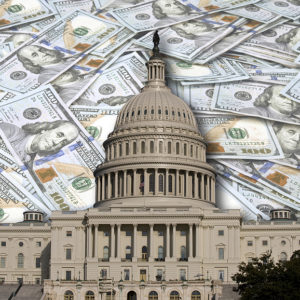Remember when President Clinton worked with the Republican-led House to balance the federal budget? That was more than 20 years ago. Where is such bipartisanship today?
Actually, there is bipartisanship on the budget. It has just been flipped on its head. Democrats and Republicans are as uninterested in balancing the budget as they are committed to growing the deficit.
While the Democrat House leadership touts a very irresponsible plan for even more COVID-19 stimulus spending, the White House is signaling its equally irresponsible alternative. In an October 6 op-ed for the Wall Street Journal, Steve Moore, a member of President Trump’s economic recovery task force, proposes a 100 percent suspension of all federal personal and corporate income taxes for 2021.
This plan would leave more than $2 trillion in the private sector. Moore is confident that it would stimulate the economy: the lowest corporate tax in the world would boost profits, stock values and business investments.
The plan may look appealing, but it defies both economic theory and reality. If anything, it would perpetuate the deficit problem and erode the stability of the U.S. economy. It is the exact opposite of the kind of economic thinking we need in order to bring down the budget deficit.
There are three reasons why the Trump administration needs to clarify if it is behind Moore’s plan.
First of all, the temporary tax relief does nothing to discourage Congress from deficit spending. While the relief idea is marketed as an alternative to more stimulus spending, it leaves the structural budget deficit intact.
Already before the COVID-19 economic shutdown, the U.S. Treasury was borrowing one quarter of every dollar it spent. With a temporary suspension of income taxes, that deficit would triple while spending continued as usual.
Secondly, the plan would not stimulate economic growth. Yes, in theory, when taxpayers get to keep more than $2 trillion during a year, we should see more economic activity. However, that theory only works if the tax cuts are permanent.
Milton Friedman was awarded the Nobel Memorial Prize in Economics in part for explaining how consumer spending is determined almost entirely by long-term factors. Temporary variations in income, especially a windfall boost like the one Steve Moore suggests, would have little to no effect on current spending.
Households and businesses would know that the tax relief is only for a year. They would not take on spending commitments that they could not afford when taxes go back to normal again in 2022.
Household debt would be paid down and long-term savings accounts would be boosted, but the growth effects of that would be scant at best.
Instead, the tax relief would find its way into the stock market, where it is not needed. Stock values are already inflated beyond reason compared to macroeconomic fundamentals. A major cash infusion could cause a stock-market bubble, which would hurt middle-class families and make long-term financial planning more difficult.
The third reason why the Trump administration should reject Moore’s plan is that it requires even more money printing to work.
A full suspension of income taxes for a year means that the federal government isolates its revenue collection from the growth effects Moore predicts. If you collect zero dollars in taxes from $200 worth of GDP, you get no more revenue than if you collect zero dollars from $100 in GDP.
Plainly, the Treasury would have to borrow more than $2 trillion — on top of what it is already borrowing. Since the U.S. government is already stretching its credit worthiness to the limit, it is de facto impossible to fund the government without the Federal Reserve.
Here is where things get downright scary.
The expansion of U.S. money supply in 2020 has already been the biggest on record. The M1 money stock was 40 percent bigger in August this year than in August 2019. Worse still: the so-called velocity of money has dropped by more than 28 percent in the same period of time and is now below one.
The velocity of money tells us how many times the same dollar is being used to pay for spending. When the velocity falls below one, there is money in our economy that is not even being used once. Just like water finds its way down a hill, money finds its way to profits; there is a reason why the stock market has done so well during the shutdown.
When idle money has bubbled up equity markets, it moves on to consumer prices. If Steve Moore’s plan went into effect and the Federal Reserve prints another $2 trillion next year (on top of the $1 trillion to fund the structural deficit) we would all need to learn how to spell “hyperinflation.”
America does not need more economic instability. We need a master plan to rein in the budget deficit, and we need iron-clad bipartisan commitment to it for the foreseeable future.
Is that too much to ask for?

